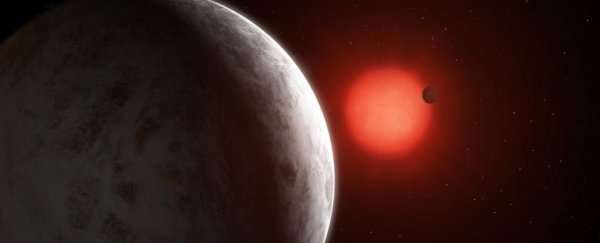In the past decade, the study of exoplanets has grown by leaps and bounds. At present, a total of 4,201 planets have been confirmed beyond the Solar System and another 5,481 candidates await confirmation.
In the midst of all this, M-type red dwarf stars have become a focus of exoplanet research because they appear to be the most likely place where rocky (AKA Earth-like) planets can be found orbiting within the star's habitable zone (HZ).
However, that does not mean that red dwarf stars are good candidates for hosting habitable planets. Take GJ 887, for example, one of the brightest M stars in the sky that has a system of two (possibly three) planets.
In the past, this star was believed to be calm and stable, but new research by astronomers from Arizona State University has shown that GJ 887 might not be as calm as previously thought.
This is discouraging news since GJ 887 (AKA Lacaille 9352), which is located just under 11 light-years from Earth, was recently confirmed to have two Super-Earths whose orbits placed them close to or within the star's HZ.
Similar findings indicated that the star itself was relatively 'boring', meaning that it was not prone to flare-ups the way other red dwarf stars are – which was seen as good news as far as its habitability was concerned.
The team's findings were recently published in the Research Notes of the American Astronomical Society (RNAAS).
The study was led by Parke Lloyd – an astrophysicist with ASU's School of Earth and Space Exploration (SESE) – who was joined by Evgenya L. Shkolnik (leader of the SESE) and researchers from the University of Colorado Boulder and the Naval Research Laboratory Space Science Division.
For the sake of their study, the team consulted archival data from the Hubble Space Telescope, which monitored GJ 887 in the ultraviolet spectrum.
What they found was that the star flared on an hourly basis, which contradicted previous findings made using data from NASA's Transiting Exoplanet Survey Satellite (TESS), which showed no detectable flares over the course of 27 days of continuous observation.
The key was to look for flares in the UV spectrum, something that Hubble is better-equipped for compared to many newer space telescopes. As Shkolnik explained, this is what allowed their team to determine that GJ 887 was "boring" after all:
"It is fascinating to know that observing stars in normal optical light (as the TESS mission does) doesn't come close to telling the whole story. The damaging radiation environment of these planets can only fully be understood with ultraviolet observations, like those from the Hubble Space Telescope."
These findings are also discouraging because they demonstrate once again that red dwarf stars, which are the most common star in the Universe (accounting for 75 percent of stars in the Milky Way alone) have a tendency to blast their planets with harmful radiation.
Along with their tendency to host rocky planets, like Proxima b or TRAPPIST-1s seven planet system, this has made them a key part in humanity's search for habitable exoplanets.
Beyond being prone to flare-ups, red dwarfs can also be deceptive in how they go about doing it. While they might appear calm in visible light (which was what GJ 887 showed) they can regularly emit flares that are only visible in other wavelengths.
Since photons in the UV wavelength have much more energy than visible light, each flare will result in an orbiting planet being bombarded by fast-moving particles that could strip its atmosphere away.
"A star's ultraviolet emission is really a critical, albeit still missing, puzzle piece to our understanding of planet atmospheres and their habitability," Shkolnik said.
While critical, the resources for conducting these studies are currently limited for astronomers. Luckily, there are plans to remedy this with the deployment of missions that can help fill the void.
For their part, ASU is leading the development of a CubeSat mission called the Star-Planet Activity Research CubeSat (SPARCS). With Shkolnik as the mission's principal investigator, this satellite will provide astronomers with observation time in the UV wavelength.
This will allow them to observe flares coming M-type stars and determine their frequency and intensity, providing insight into the chances life has to emerge on their exoplanets.
"If the genesis of life on a planet is more a less a roll of the dice, then M stars are rolling those dice far more than any other type of star," said Loyd.
And as other research has shown, the tendency of red dwarfs to flare up need not mean that any planet orbiting them is doomed to become airless and sterile. In fact, it has been found that the presence of a sufficient atmosphere and cloud cover would allow a window for life to emerge.
This means that planets like Proxima b, the closest planet to our Solar System that orbits the red dwarf star right next door (Proxima Centauri), could actually have a stable climate and life on its surface!
Then again, it's entirely possible that the planet is a "water world" with unfathomably deep oceans. The only way to find out is to keep observing, and maybe send a mission there someday…
This article was originally published by Universe Today. Read the original article.
